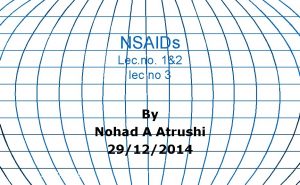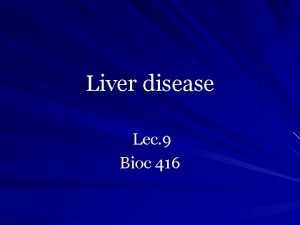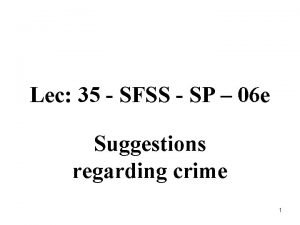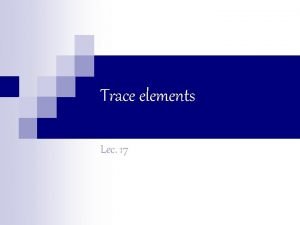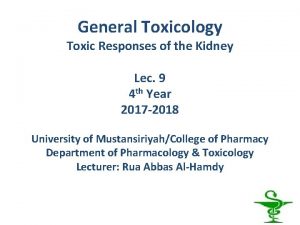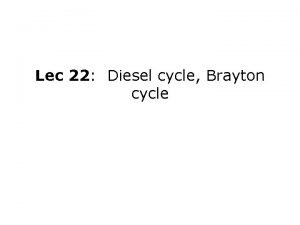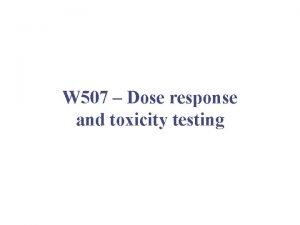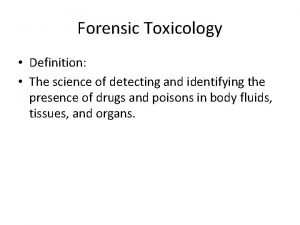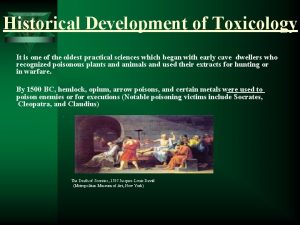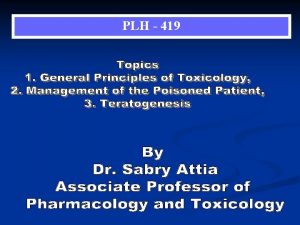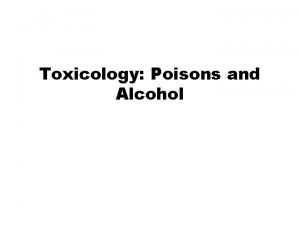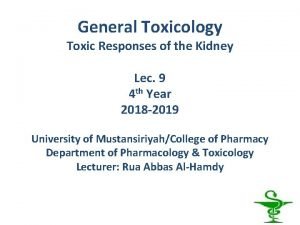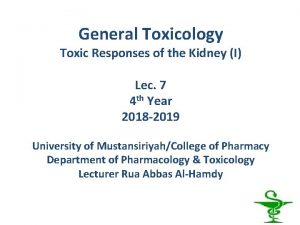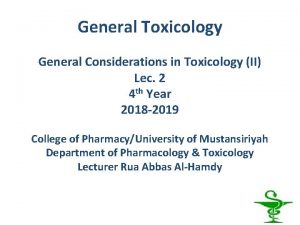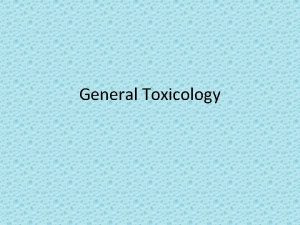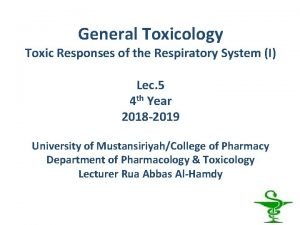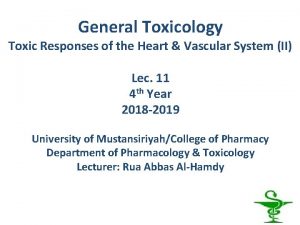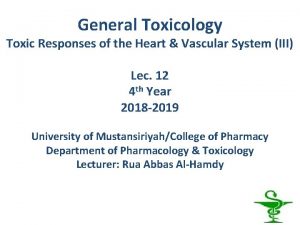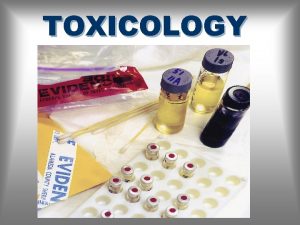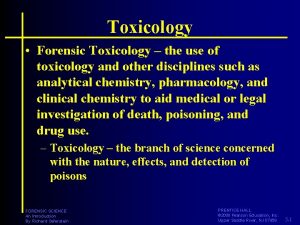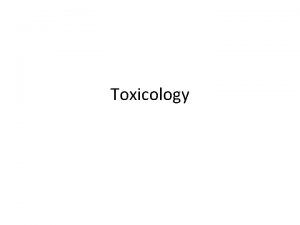General Toxicology Toxic Responses of the Kidney Lec






































- Slides: 38

General Toxicology Toxic Responses of the Kidney Lec. 9 4 th Year 2017 -2018 University of Mustansiriyah/College of Pharmacy Department of Pharmacology & Toxicology Lecturer: Rua Abbas Al-Hamdy

Objectives of this lecture are to: § determine kidney functions & its functional anatomy. § Explain the pathophysiologic responses of the kidney. § determine the reasons for the susceptibility of the kidney to toxicity & the reasons for siteselective injury. § explain some examples of specific nephrotoxicants. § determine the mechanism of toxicity & the nephrotoxic effects induced by mercury & cadmium.

Kidney functions: The functional integrity of the mammalian kidney is vital to total body homeostasis because: § The kidney plays a principal role in the excretion of metabolic wastes & the regulation of extracellular fluid volume, electrolyte composition, & acid–base balance. § The kidney synthesizes & releases hormones, such as renin & erythropoietin, & metabolizes vitamin D 3 to the active 1, 25 -dihydroxy vitamin D 3 form.

Functional anatomy: § Gross examination of a sagittal section of the kidney reveals three clearly demarcated anatomic areas: the cortex, medulla, & papilla. § The cortex constitutes the major portion of the kidney and receives a disproportionately higher percentage (90%) of blood flow compared to the medulla (~ 6% to 10%) or papilla (1% to 2%). Thus, when a blood-borne toxicant is delivered to the kidney, there will be a greater opportunity to influence cortical rather than medullary or papillary functions.

§ However, medullary & papillary tissues are exposed to higher luminal concentrations of toxicants for prolonged periods of time, because of: • the more concentrated tubular fluid, & • the more sluggish flow of blood & filtrate in these regions. § The functional unit of the kidney, the nephron, may be considered in three portions: the vascular element, the glomerulus, & the tubular element (Figure 1).

Figure 1. Schematic of the human kidney showing the major blood vessels and the microcirculation and tubular components of each nephron.

Renal vasculature & glomerulus: § Both the afferent & efferent arterioles control glomerular capillary pressure & glomerular plasma flow rate. § These arterioles are innervated by the sympathetic nervous system & respond to nerve stimulation, angiotensin II, vasopressin, anti-diuretic hormone (ADH), endothelin, adenosine, & norepinephrine.

§ Postglomerular capillary loops provide delivery of nutrients to the postglomerular tubular structures, delivery of wastes to the tubule or excretion, & return of reabsorbed electrolytes, nutrients, & water to the systemic circulation. § The glomerular capillary wall provides a significant barrier to the transglomerular passage of macromolecules. Thus, small molecules, such as insulin (MW~5500), are freely filtered, whereas large molecules, such as albumin (MW 56 000– 70 000), are restricted.

§ Filtration of anionic molecules tends to be restricted compared to that of neutral or cationic molecules of the same size; this is primarily due to the charge-selective properties of the glomerular basement membrane.

Proximal tubule: § The proximal tubule consists of three discrete segments: the S 1 (pars convoluta), S 2 (transition between pars convoluta & pars recta), & S 3 (pars recta) segments. § It reabsorbs approximately 60% to 80% of solute & water filtered at the glomerulus. § It also reabsorbs virtually all the filtered lowmolecular-weight proteins. § An important excretory function of the proximal tubule is secretion of weak organic anions into tubular fluid.

Loop of Henle: § Approximately 25% of the filtered Na+ & K+ & 20% of the filtered water are reabsorbed by the segments of the loop of Henle. § The relatively high rates of Na+ , K+ -ATPase activity & oxygen demand, coupled with the meager oxygen supply in the medullary thick ascending limb, are believed to contribute to the vulnerability of this segment of the nephron to hypoxic injury.

Distal tubule & collecting duct: § The early distal tubule reabsorbs most of the remaining intraluminal Na+, K+, & Cl- but is relatively impermeable to water. § The late distal tubule, cortical collecting tubule, & medullary collecting duct perform the final regulation & fine-tuning of urinary volume & composition. § Chemicals that interfere with ADH action impair the concentrating ability of the distal nephron.

Pathophysiologic responses of the kidney: § Acute kidney injury § Chronic kidney disease

Acute kidney injury: § One of the most common manifestations of nephrotoxic damage is acute renal failure or acute kidney injury (AKI). § AKI is characterize by an abrupt decline in glomerular filtration rate (GFR) with resulting azotemia, or a build up of nitrogenous wastes in the blood. § AKI describes the entire spectrum of the disease & is defined as a complex disorder that comprises multiple causative factors with clinical manifestations ranging from minimal elevation in serum creatinine to anuric renal failure.

§ Decline in GFR may result from: • Prerenal factors (renal vasoconstriction, intravascular volume depletion, & insufficient cardiac output), • Postrenal factors (ureteral or bladder obstruction), & • intrarenal factors (glomerulonephritis, tubular cell injury, death, & loss resulting in back-leak; renal vasculature damage; interstitial nephritis). § Table 1 provides a partial list of chemicals that produce AKI through different mechanisms.

Table 1 Mechanisms of chemically induced acute kidney injury Prerenal Vasoconstriction Crystalluria Tubular toxicity Diuretics Nonsteroidal antiinflammatory drugs (NSAIDs) Sulfonamides Aminoglycosides Angiotensin receptor antagonists Cyclosporine Methotrexate Cisplatin Angiotensin converting enzyme inhibitors Amphotericin B Acyclovir Heavy metals

Endothelial injury Cyclosporine Glomerulopathy Gold Interstitial nephritis Antibiotics Conjugated estrogens Penicillamine Nonsteroidal antiinflammatory drugs Quinine Diuretics NSAIDs

Chronic kidney disease: § Progressive deterioration of renal function may occur with long-term exposure to various chemicals (e. g. , analgesics, lithium, & cyclosporine). § Following nephron loss, adaptive increases in glomerular pressures & flows increase the singlenephron GFR of remnant viable nephrons, which serve to maintain whole-kidney GFR. § With time, these alterations are maladaptive, & focal glomerulosclerosis eventually develops that may lead to tubular atrophy & interstitial fibrosis.

Reasons for the susceptibility of the kidney to toxicity: § Although the kidneys constitute only 0. 5% of total body mass, they receive about 20% to 25% of the resting cardiac output. Consequently, any drug or chemical in the systemic circulation will be delivered to the kidneys in relatively high amounts. § The processes involved in forming concentrated urine serve to concentrate potential toxicants in the tubular fluid. Therefore, a nontoxic concentration of a chemical in the plasma may reach toxic concentrations in the kidney & its

§ Renal transport, accumulation, & metabolism of xenobiotics contribute significantly to the susceptibility of the kidney to toxic injury. § In addition to intrarenal factors, the incidence & /or severity of chemically induced nephrotoxicity may be related to the sensitivity of the kidney to circulating vasoconstrictors (angiotensin II or ADH), whose actions are normally counterbalanced by the actions of increased vasodilatory prostaglandins. When prostaglandin synthesis is suppressed by NSAIDs, renal blood flow (RBF) declines markedly & AKI ensues due to the unopposed actions of vasoconstrictors.

Site-selective injury: The reasons underlying this site-selective injury are complex but can be attribute in part to: § site-specific differences in blood flow, § transport & accumulation of chemicals, § reactivity of cellular/molecular targets, § balance of bioactivation/ detoxification reactions, § cellular energetics, &/ or § regenerative/repair mechanisms.

Glomerular injury: § The glomerulus is the initial site of chemical exposure within the nephron, & a number of nephrotoxicants produce structural injury to this segment. § In certain instances, chemicals alter glomerular permeability to proteins by altering the size- & charge-selective functions. § Cyclosporine, amphotericin B, & gentamicin impair glomerular ultrafiltration without significant loss of structural integrity & decrease GFR.

Proximal tubular injury: The proximal tubule is the most common site of toxicant-induced renal injury. The reasons for this are: § This relates in part to the selective accumulation of xenobiotics into this segment of the nephron. The proximal tubule has a leaky epithelium, favoring the flux of compounds into proximal tubular cells. § More importantly, tubular transport of organic anions & cations, low-molecular-weight proteins & peptides, GSH conjugates, & heavy metals is localized primarily if not exclusively to the proximal tubule.

§ Differences in cytochrome P 450 & cysteine conjugate β-lyase activity also are contributing factors to the enhance susceptibility of the proximal tubule. Both enzyme systems are localized almost exclusively in the proximal tubule, with negligible activity in the glomerulus, distal tubules, or collecting ducts. § Finally, proximal tubular cells appear to be more susceptible to ischemic injury than distal tubular cells.

Loop of Henle/distal tubule/collecting duct Injury: § Functional abnormalities at distal nephron sites manifest primarily as impaired concentrating ability &/or acidification effects. § Amphotericin B, cisplatin, & methoxyflurane induce an ADH-resistant polyuria, suggesting that the concentrating defect occurs at the level of the medullary thick ascending limb &/or the collecting duct.

Papillary injury: § The renal papilla is susceptible to the chronic injurious effects of abusive consumption of analgesics. § The initial target of abusive consumption of analgesics is the medullary interstitial cells, followed by degenerative changes in the medullary capillaries, loops of Henle, & collecting ducts. § High papillary concentrations of potential toxicants & inhibition of vasodilatory prostaglandins compromise RBF to the renal medulla/papilla & result in tissue ischemia.

Specific nephrotoxicants: § Heavy metals: Mercury Cadmium § Halogenated hydrocarbons: Chloroform Tetrafluoroethylene § Therapeutic agents: Acetaminophen Cyclosporine NSAIDs Cisplatin Aminoglycosides Radiocontrast agents Amphotericin B

Heavy Metals: § Many metals, including cadmium, chromium, lead, mercury, platinum, & uranium, are nephrotoxic. § The nature & severity of metal nephrotoxicity varies with respect to its form. § Different metals have different primary targets within the kidney. § Metals may cause renal cellular injury through their ability to bind to sulfhydryl groups of critical proteins within the cells & thereby inhibit their normal function.

Mercury: § Humans & animals are exposed to elemental mercury vapor, inorganic mercurous & mercuric salts, & organic mercuric compounds through the environment. § Due to its high affinity for sulfhydryl groups, virtually all of the Hg 2+ found in blood is bound to cells—albumin, other sulfhydryl-containing proteins, glutathione, & cysteine.

§ The kidneys are the primary target organs for accumulation of Hg 2+, & the S 3 segment of the proximal tubule is the initial site of toxicity. As the dose or duration of treatment increases, the S 1 & S 2 segments may be affected. § The acute nephrotoxicity induced by Hg. Cl 2 is characterized by proximal tubular necrosis & AKI within 24 to 48 hours after administration.

§ Early markers of Hg. Cl 2 -induced renal dysfunction include an increase in the urinary excretion of brush-border enzymes such as alkaline phosphatase & γ-glutamyl transpeptidas (γ-GT), suggesting that the brush border may be an initial target of Hg. Cl 2. § As injury progresses, tubular reabsorption of solutes & water decreases & there is an increase in the urinary excretion of glucose, amino acids, albumin, & other proteins.

§ Associated with the increase in injured proximal tubules is a decrease & progressive decline in the GFR. The reduction in GFR results from the glomerular injury, tubular injury, &/or vasoconstriction. § Inorganic mercury has a very high affinity for protein sulfhydryl groups, & this interaction is thought to play an important role in the toxicity of mercury at the cellular level.

§ Mitochondrial dysfunction is an early & important contributor to inorganic mercury-induced cell death along the proximal tubule. § Several animal studies have shown that chronic exposure to inorganic mercury results in an immunologically mediated membranous glomerular nephritis.

Cadmium: § Chronic exposure of nonsmoking humans & animals to cadmium is primarily through food & results in nephrotoxicity. § Cadmium has a half-life of greater than 10 years in humans & thus accumulates in the body over time. Approximately 50% of the body burden of cadmium can be found in the kidney. § Cadmium produces proximal tubule dysfunction (S 1 & S 2 segments).

§ This injury is characterized by increases in urinary excretion of glucose, amino acids, calcium, & cellular enzymes. This injury may progress to a chronic interstitial nephritis. § A very interesting aspect of cadmium nephrotoxicity is the role of metallothioneins. Metallothioneins are a family of low-molecularweight, cysteine-rich metal-binding proteins that have a high affinity for cadmium & other heavy metals.

§ In general, the mechanism by which metallothionein is thought to play a role in cadmium toxicity is through its ability to bind to cadmium & thereby render it biologically inactive. This assumes that the unbound or “free” concentration of cadmium is the toxic species. § Following an oral exposure to Cd. Cl 2 , Cd 2+ is thought to reach the kidneys both as Cd 2+ & Cd 2+metallothionein complex. § The Cd 2+-metallothionein complex is freely filtered by the glomerulus & reabsorption by the proximal tubule is probably by endocytosis & is limited.

§ Inside the tubular cells, it is thought that lysosomal degradation of the Cd 2+metallothionein results in the release of “free” Cd 2+, which, in turn, induces renal metallothionein production. Once the renal metallothionein pool is saturated, “free” Cd 2+ initiates injury. § The mechanism by which Cd 2+ produces injury at the cellular level is not clear; however, low concentrations of Cd 2+ have been shown to interfere with the normal function of several cellular signal transduction pathways.

 Art 455 lec
Art 455 lec Xyloprin
Xyloprin Scoreboarding computer architecture
Scoreboarding computer architecture Sekisui slec
Sekisui slec Tura analítica
Tura analítica August lec 250
August lec 250 252 lec
252 lec Lec promotion
Lec promotion Scoreboard architecture
Scoreboard architecture Lec
Lec Lecsl
Lecsl Componentes del lec
Componentes del lec 416 lec
416 lec Underground pipeline for irrigation
Underground pipeline for irrigation Lec anatomia
Lec anatomia 11th chemistry thermodynamics lec 13
11th chemistry thermodynamics lec 13 132000 lec
132000 lec 11th chemistry thermodynamics lec 10
11th chemistry thermodynamics lec 10 Lec hardver
Lec hardver Lec
Lec Lec 1
Lec 1 Lec hardver
Lec hardver Lec ditto
Lec ditto Ir.ac.kashanu.register://h
Ir.ac.kashanu.register://h Lec elements
Lec elements Lec renal
Lec renal Brayton cycle
Brayton cycle Importance of toxicology
Importance of toxicology Toxicology definition
Toxicology definition Important dates in forensic science
Important dates in forensic science Definition of forensic toxicology
Definition of forensic toxicology Hormesis ne demek
Hormesis ne demek Examples of toxicology
Examples of toxicology Toxicology defination
Toxicology defination Toxicology management
Toxicology management Chapter 21 toxicology
Chapter 21 toxicology Toxicology effects
Toxicology effects Toxicology and applied pharmacology
Toxicology and applied pharmacology Definition of environmental toxicology
Definition of environmental toxicology

